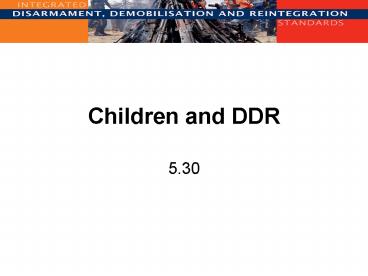Children and DDR PowerPoint PPT Presentation
1 / 12
Title: Children and DDR
1
Children and DDR
- 5.30
2
Overview
- Introduction
- Guiding principles
- Girls
- Prevention of recruitment and re-recruitment of
children
- Disarmament and demobilization
- Reintegration
- Conclusion
3
Introduction
- The use of children under the age of 18 in armed
conflict is illegal - Children cannot be legally recruited
- Optional Protocol of the Convention of the Rights
of the Child - UN Security Council resolutions
4
Guiding Principles
- Guiding principles from the Convention on the
Rights of the Child - The childs right to life, survival and
development - Non-discrimination
- Child participation
- Childs best interests
5
- Programming
- Technical and operational leadership by
specialized child protection agencies - Ensure inclusive programming for all war-affected
children - Ensure age-appropriate interventions for each age
group - Strengthen existing local capacities
- Participatory and decentralized consultation
- Government should be a key partner/owner
- Systems of coordination and information-sharing
- Training in all matters relating to children
- Staff should gather and process information on
children - Protective rules have to be established
- The media should respect rules governing
reporting on and interviewing children - The reintegration of children is a long-term
process
6
- Situation analysis
- Planning
- Carrying out the situation analysis
- Developing programme implementation and
monitoring and evaluation mechanisms - Specifying roles and responsibilities of
stakeholders - Assuring funding sustainability
- Developing strategies of engagement and exit
7
- Communication and awareness-raising
- Advocacy at peace negotiations
- Access of children to DDR programs
- Criminal responsibility
8
Girls
- Identification and access to demobilization
processes - Containment sites and interim facilities
- Reintegration support
- Violence, sexual abuse and exploitation
- Girl mothers and their children
9
Prevention of Recruitment and Re-recruitment of
Children
- Documentation and identification of risks of
recruitment - Creation of a protective environment
- Sensitizing combatants, ex-combatants and
commanders - Community-level advocacy
- Security sector reform
- Monitoring and reporting on use and recruitment
of children
10
Disarmament and Demobilization
- Disarmament
- Containment and interim care centres
- Transition from military to civilian life
- Spontaneous demobilization
- Cash payments and benefit packages
- Documentation
- Transport
- Data management
- Family tracing and reunification
11
Reintegration
- Psychosocial support and special care
- Inclusive programming for all was affected
children - The role of communities
- Education, training and livelihoods
- Follow-up and monitoring
12
Conclusion

